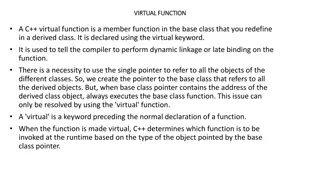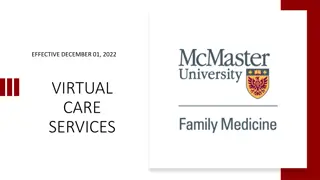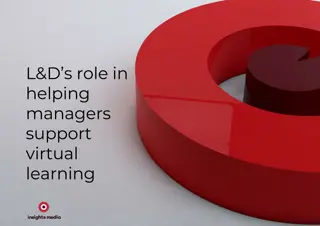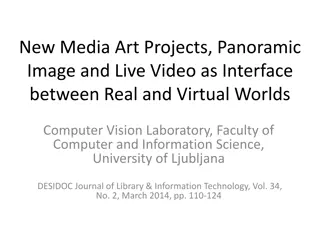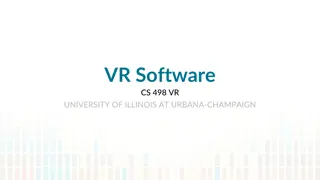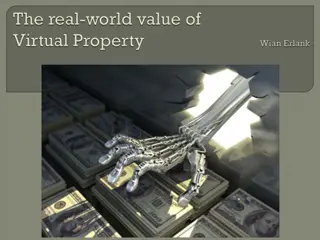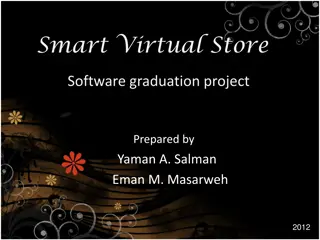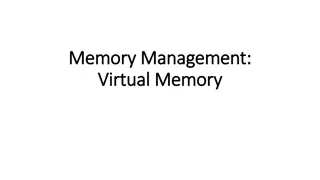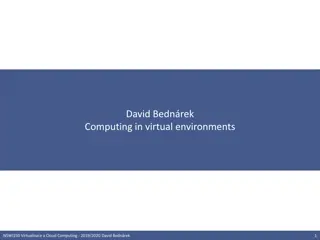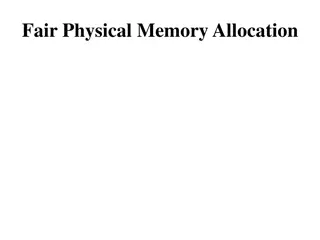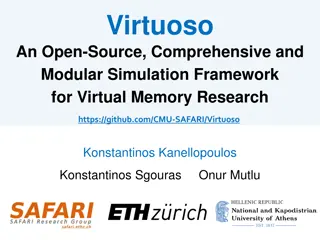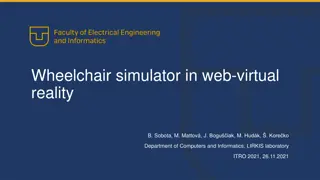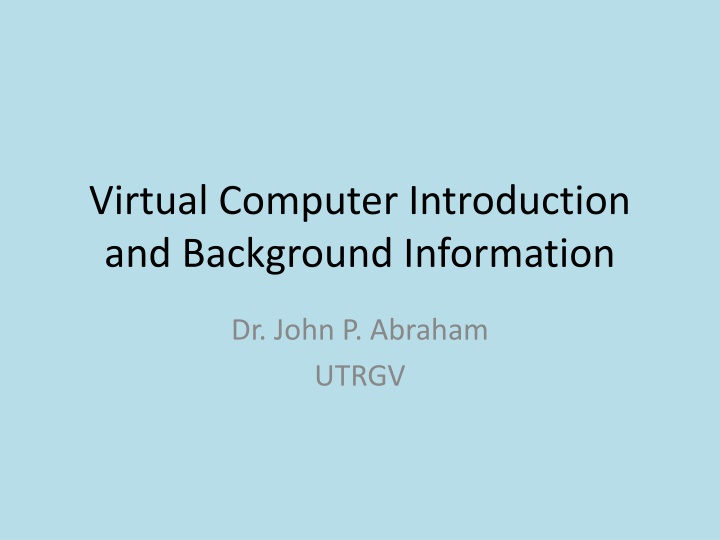
Virtual Computer Components and Operations
Explore the major microprocessor components and operations involved in a virtual computer system, including the role of various registers and memory units. Learn how a program executes instructions through the interaction of program counters, memory buffers, and more at the University of Texas Pan Am under the guidance of Dr. John P. Abraham.
Download Presentation

Please find below an Image/Link to download the presentation.
The content on the website is provided AS IS for your information and personal use only. It may not be sold, licensed, or shared on other websites without obtaining consent from the author. If you encounter any issues during the download, it is possible that the publisher has removed the file from their server.
You are allowed to download the files provided on this website for personal or commercial use, subject to the condition that they are used lawfully. All files are the property of their respective owners.
The content on the website is provided AS IS for your information and personal use only. It may not be sold, licensed, or shared on other websites without obtaining consent from the author.
E N D
Presentation Transcript
Virtual Computer Introduction and Background Information Dr. John P. Abraham UTRGV
Major microprocessor components PC- Program Counter MBR- Memory Buffer Register MAR- Memory Address Register ALU- Arithmetic Logic Unit IR- Instruction Register General Purpose Registers. University of Texas Pan Am Dr. John P. Abraham
University of Texas Pan Am Dr. John P. Abraham
operation When a program begins execution, the program counter (PC, a register inside the CPU) has the address of the next instruction to fetch. this address is placed there initially by the operating system and updated automatically by the CPU. There are three additional registers, the instruction register (IR), memory address register (MAR) and the memory buffer register (MBR) that work together to fetch the instruction. University of Texas Pan Am Dr. John P. Abraham
Operation (2) The address from the PC is moved to the MAR. The reason for this is that the address bus is connected to the MAR and all addresses issued must go through this register. Then the address contained in the MAR is placed on the address bus and the READ line is asserted on the control bus. University of Texas Pan Am Dr. John P. Abraham
Operation(3) The memory whose address is found on the address bus places its contents on the data bus. The only register that is connected to the data bus is the MBR, and all data should go in an out through this register. Thus the data on the data bus is copied into the MBR. The instruction is now copied on to the IR to free up the MBR to handle another transfer. University of Texas Pan Am Dr. John P. Abraham
Operation(4) The contents of the PC will be now incremented by one instruction. The instruction is then decoded and executed. In practice, more than one instruction is read during an instruction cycle. Additional instructions are kept in temporary storage registers such as the Instruction Buffer Register (IBR). University of Texas Pan Am Dr. John P. Abraham
Main Memory System When small memory was available we used overlays. Talk about overlays Virtual Memory Main memory and secondary memory are considered to contiguous The OS maintains special tables that keep track of where each part of the program reside in main memory and in external storage
Memory hierarchy of multilevel storage system Registers internal cache (in CPU-SRAM) external cache (outside CPU-SRAM or DRAM) Main Memory Secondary Memory
Program relocation and Memory Protection Crucial features needed for multiprogramming: program relocation memory protection privileged modes of operation timer interrupts
Cache Memory When CPU access a piece of information from memory , there is a high possibility that this data or adjacent data will be accessed again. during a memory read, it also reads adjacent memory locations and places the data in the cache cache entries include address tags where the data came from. So each cache consists of data and data tag.
Cache contd. When CPU finds what it is looking for in the cache it is called a hit when it does not find the data it is called a miss. Most cache memory has a 90% hit rate when a write is done, cache is updated, and if memory is updated immediately it is called write-through cache. If memory update is delayed it is called write- back cache. The cache may wait until entire block needs to be written. A dirty cell is the main memory that has not been updated yet, but the cache has.
Cache structure and organization cache has two sub-systems. Tag and memory subsystem. Memory and cache are divided into refill lines. Refill lines are unit of data transfer. (several words, up to 64 bytes) Cache has to map main memory to its own, techniques associative direct mapped set associate sector-mapped
Background Next few slides will give you some background information You may have had this in other courses So it will be brief
Virtual Memory Logical address space is larger than physical address space. For example if computer is designed with 32 bit address bus it can have 4GB of memory; 64 bit can have more than 16 exabytes of addressable memory. Practically most computers have far less physical memory. virtual memory makes it appear that the physical memory is as much as the logical memory Programmer, therefore, do not have to use overlays.
Virtual memory CPU uses MMU (memory management unit) to locate Page in RAM MMU provides mapping to Physical memory Table with DirtyBit, Resident Bit, and Physical Page number is used to determine if page available in Virtual memory pages. Virtual memory should have more than 90% hit rate.
Virtual memory When a memory is needed the effective address is calculated. The effective address is sent to a memory map (which is part of the virtual memory hardware) The memory map checks to if the effective address is active, if it is This memory map translate the effective address to the physical address. If it is not, the memory map interrupts the CPU to load it.
Paging Hardware technique for managing physical memory. Only what is currently needed is loaded into memory. In a paging system, the virtual memory hardware divides logical address into two parts. A virtual page number and word offset the high order bits are the page number the low order bits are the offset
Paging The application program uses logical addresses. The OS convert the logical to physical address during execution. The last page may not be enough to fill a frame. So still some fragmentation will exist.
Virtual memory A program may have many subroutines, some may never be used. Some subroutines may only be executed once then not needed afterwards. While a program is executing a loop, those programs outside the loop is not needed for a while. Many array elements will never be filled. All these are reasons why only needed portions be loaded into memory.
Virtual memory The set of active pages is called the working set. As the program progresses, new pages enter working set and old ones leave. Demand paging: when needed portion is not in memory the OS simply loads it. When needed page is not in memory it is called page fault. When lots of page faults occur, it is called page thrashing.
Virtual memory If the allocated memory is full, but still needs to load a new page, the operating system replaces a new page with one that is no longer needed. Before OS can release a page and replace with a new one, it must decide the contents were changed. If it was changed the changes must be written to disk drive. To keep track if it was changed, the OS keeps a dirty bit. The page is loaded into memory the dirty bit is set to zero. If the STORE instruction was issued, then the dirty bit is set to one.
Cache memory vs. virtual memory Both share several features. Both systems use hardware that maps one set of address to another. Both hold data for the CPU. Both operate on demand basis, replacing older data with newer data as the CPU requests it.
Differences They are different in their purpose Cache to speed up Virtual to run large programs on smaller machines Cache misses occur more frequently refill lines of cache are much smaller than pages.
Single machine, single OS Each OS is bound to the underlying hardware Each application program is bound to the OS If the hardware fails in order to restore the backup, same hardware and OS are needed.
Single machine, single OS Only one OS may run at a time. If more than one OS is installed, you will need to choose the OS at boot up. CPU use of a stand alone server or computer is only about 10% 90% of the time it is idle. Implied waste of money is 90% of investment plus manpower needed to keep up the hardware and software.
Virtual Machine Each virtual machine is treated as a process and a file So virtual memory table can be modified to include a VM number and virtual page number. Each virtual machine can now have a virtual page 0. CPU gives a time slice to each virtual machine Virtual machines take away dependence on the hardware. Virtual drivers are generic drivers that can be used by any operating system or version
Virtual Machine Creates pools CPU pool Memory Pool Storage Pool Interconnection Pool Hypervisor manages allocation of these pools to Virtual Machines
Virtual machine lifecycle Create, Suspend, Resume, Save, migrate, and destroy Each VM can have an OS and a VM Monitor (hypervisor). Virtual Infrastructure Managers (VIM) are used to manage, deploy and monitor Virtual Machines.
Two approaches to virtualization "hosted" (paravirtualization) and "bare-metal (full virtualization). Hosted virtualization software runs as an application or "guest" on top of a general- purpose operating system. Host treats each Virtual OS as a process. Guest works as if it is on an actual hardware. Bare-metal virtualization interfaces directly with computer hardware, without the need for a host operating system. Even BIOS is virtualized (emulated).
Virtual Machine Software functions Partitioning Multiple VM on a single hardware pool Isolation - Each VM is isolated from others Encapsulation VM encapsulates hardware, OS and application Hardware independence RUN VM on any machine without modification
VM software Vmware VirtualBox Microsoft HyperV for windows 10 Pro Citrix XenServer Hypervisor Xen open source Others: 5G core Labs, Azure Virtual Machine Some are free, others have paid and free releases.
Core Mechanism behind a VM software None of the high level languages can use the hardware directly. HL programs need to be compiled. Compiler creates Machine executable Code High level languages such as Python, JAVA, and Ruby have their own Virtual Machines For VMs, create bytecodes. Bytecodes can be compiled (runtime) to machine codes.
Advantages of VM Host machine is not affected by misbehaving software. VMs can be networked thus, we use this feature for this networking class Can access Internet Some older software requiring specific older hardware software configurations can be virtualized. For example a software that runs on windows 98 or XP.
How to create a VM software CPUs work by fetching, decoding and executing.
Instruction set of an imaginary computer University of Texas Pan Am Dr. John P. Abraham
Operations of a Microprocessor This hypothetical computer has only one user addressable register, which is the accumulator (AC). When a load (LD) is executed, the contents of the location as indicated by the operand is brought into the AC The reverse happens in a store (ST). University of Texas Pan Am Dr. John P. Abraham
Operations of a Microprocessor(2) When an add (A) is executed, the value contained in the memory location as indicated by the operand is added to the contents of the AC, and the result is placed back in the AC. The add immediate (AI) differs from the add (A) in that the operand is what is added, not the content of the memory pointed by the operand. University of Texas Pan Am Dr. John P. Abraham
Program Example B = B + A C = B + 2 The variable A is kept in memory location 200h Variable B in 201h Variable C in 202h. The values in each are 5, 3 and 0 respectively. University of Texas Pan Am Dr. John P. Abraham
Program Example (2) There are three registers that need watching, the Accumulator (AC), Program Counter (PC), and the Instruction Register (IR). The PC contains 100h, which means that the next instruction should be fetched from memory location 100 hexadecimal. University of Texas Pan Am Dr. John P. Abraham
Program Example (3) The code University of Texas Pan Am Dr. John P. Abraham
Program Example (4) The control unit fetches the instruction contained in the address indicated by the PC, which is 100h. The instruction 0200 is brought into the IR. The IR now contains 0200. The instruction is decoded and separated in opcode of 0 and operand of 200. This is based on the assumption that 4 bits (one hexadecimal digit) are used for the opcode and 12 bits (three hexadecimal digits) are used for the operand. University of Texas Pan Am Dr. John P. Abraham
University of Texas Pan Am Dr. John P. Abraham
Program Example (5) Once the instruction is fetched the PC is automatically incremented, and now contains 101h. The opcode 0 indicates a load, and the operand is fetched from memory location 200h and loaded into the accumulator (AC). Now the accumulator contains 5. University of Texas Pan Am Dr. John P. Abraham
University of Texas Pan Am Dr. John P. Abraham
Program Example (6) The instruction from 101h is fetched and placed in the IR. The PC is incremented to 102h. The content of IR is decoded and based on the opcode of 2, the operand located in address 201h is added to the AC. The AC now has a value of 8. University of Texas Pan Am Dr. John P. Abraham
Program Example (7) The next instruction whose address is contained in the PC is fetched and placed in the IR giving it a value of 1201. The PC is incremented to 103h. The contents of IR (1201) is decoded and based on the opcode of 1, the contents of the AC is saved in the address indicated by the operand, which is 201h. Address 201 (variable B) now has a value of 8. University of Texas Pan Am Dr. John P. Abraham
University of Texas Pan Am Dr. John P. Abraham
Program Example (8) The instruction contained in 103h (PC content) is fetched next and placed in the IR giving it a value of 3002. The PC is incremented to 104h The contents of IR is decoded, and based on the opcode of 3 it is an add immediate. No data fetching is necessary and the 2 is added to the AC. The new value of the accumulator is now 10. University of Texas Pan Am Dr. John P. Abraham

